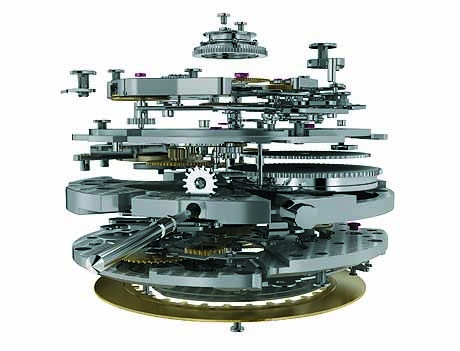Re: Ulysse Nardin
Δημοσιεύτηκε: Παρ Μαρ 30, 2012 3:18 pm
Baselworld 2012 - PuristSPro report: Ulysse Nardin
2012 - for Ulysse Nardin this is the first Basel fair without its energetic and charismatic leader Rolf Schnyder, who had passed away so suddenly in April 2011. As a consequence, many were uncertain about the company’s new course, some even predicted a decrease of impetus and innovation.
Gladly, this year’s fair demonstrate the opposite: Aside personal loss and grief, nothing seems to have changed, regarding Ulysse Nardin’s energy devoted to innovative technologies, the presentation of new models, and the consolidation of existing lines. Mainly responsible for that is the continuity within the company’s leadership: Already several years ago, Patrik Hoffmann, long-time head of Ulysse Nardin’s North American business, was appointed CEO and designated the successor of Rolf Schnyder in leading the company. Consequently, the business was not fatally interrupted by Rolf’s death.
For me, 2012 was the first year since thirteen years that I could not attend the Basel fair myself; a pneumonia had forced me to stay at home in the last moment. Therefore, my comments on the new models are based on my friends’ and colleagues’ observations solely. I also express my sincere thanks to Don and Francois-Xavier for supplying me the pictures they shot of the various novelties.
After Ulysse Nardin has amply demonstrated its competence to build state-of-the-art movements with complications, employing latest material and part design technologies, speculations about an own base movement were active during the last years. It is no secret that Ulysse Nardin heavily relied on base movements supplied by ETA in its most numerously produced watch lines, such as the Marine series, or the various GMT models. Since the Swatch Group announced the slow reduction of movement sales to companies not part of the group, it was clear that an alternative had to be found.
In 2011, Ulysse Nardin presented the cal. 118, a solid base movement, equipped with high-end escapement technology: while the escapement design relied on the traditional Swiss lever, the materials used are exclusive to Ulysse Nardin - anchor, escapement wheel and hairspring being made from DiamonSil, a silicium core vapour coated with synthetic diamond.
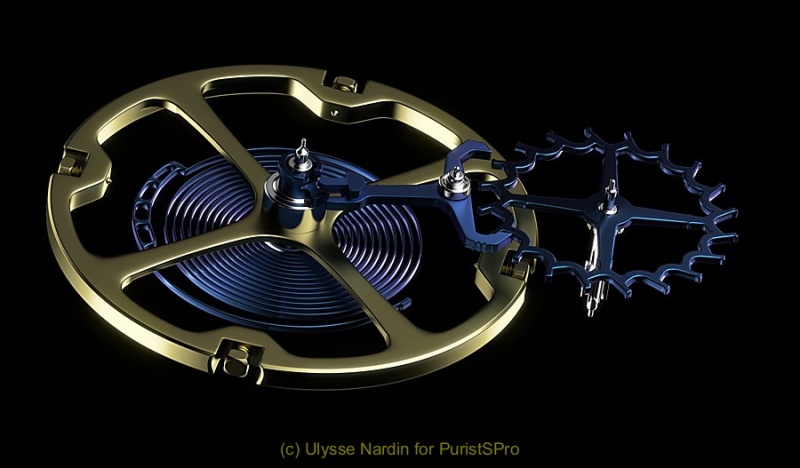
All these components are produced by Sigatec, a leading company specialised on the development and production of nano-parts from silicium, synthetic diamond - or the combination of these two materials. Ulysse Nardin owns a major share of this company, that also delivers components to many other watch manufacturers.
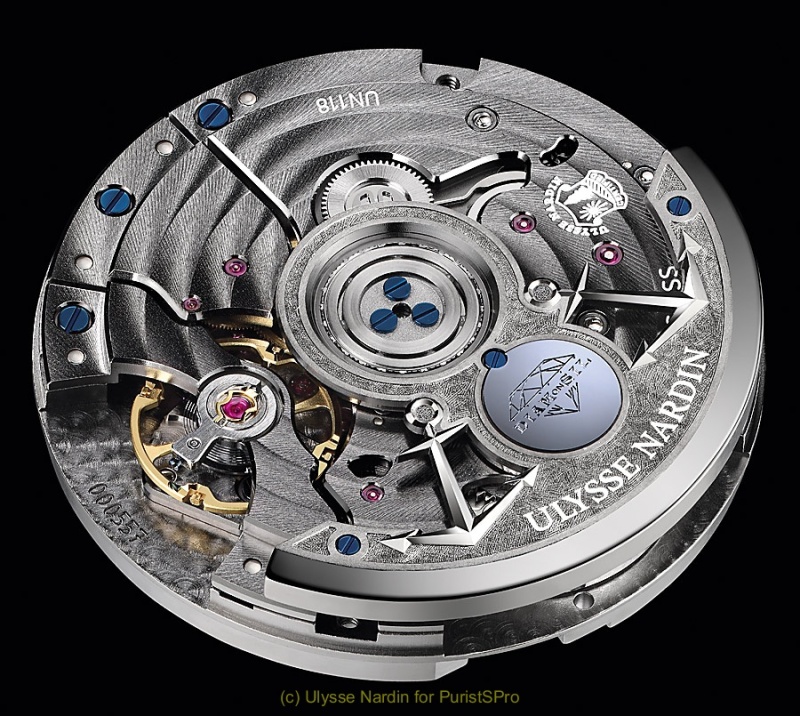
Closer examination of this movement made clear that it would become the new base movement of the Marine series: a power reserve display at 12, and a small second at 6, combined with a conventional date at 6 (no big date), that can be quick-set forward and backward. While up to now, a self-produced module was necessary to add the typical configuration to an ETA 2892A2, the new cal. 118 has everything on board needed by the Marine series watches.
Thus it was only a question how the new Marine chronometers would look, when finally, they were released at this year’s Basel fair. The first sight fell on the limited series Marine Chronometer in 18k pink gold case, with a white enamel dial and finely printed Roman numerals: not that much of a difference with what we are used to, I thought. The increased diameter of 45mm, however, already indicates the changes.
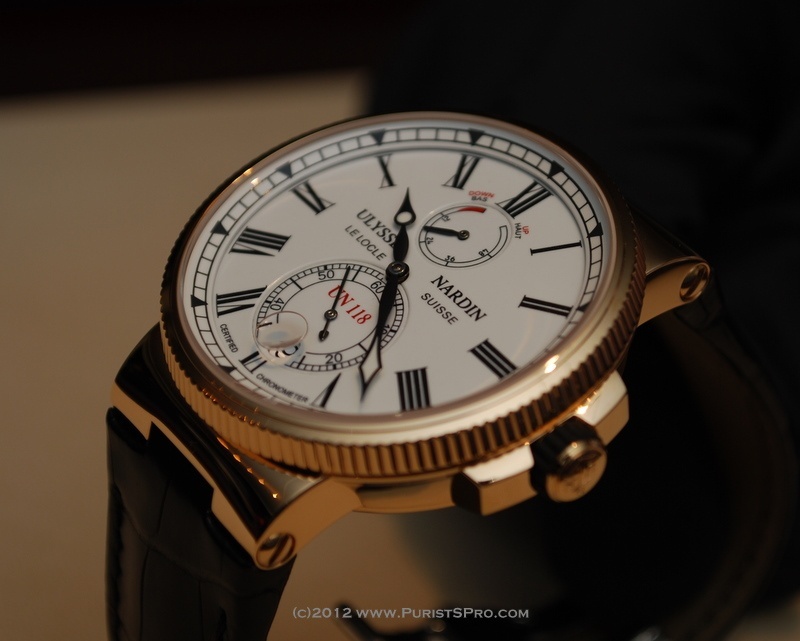
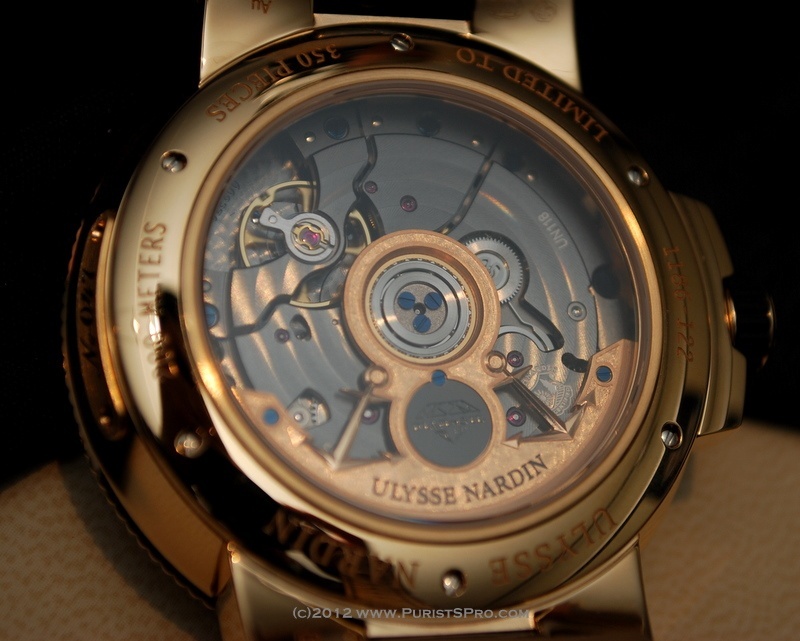
Not all are happy about the large case. When the first Marine Chronometer was launched in 1996, it had a diameter of a bit more than 38mm. Times and fashion have changed since, the latest variant, the Maxi Marine, already has a diameter of 43mm, still retaining the original base movement with only 25.6mm diameter. The new cal. 118 is considerably larger (about 5mm), since it was designed from the outset to be robust and reliable. It is thus not astonishing to see the case grown as well. Yet the friends of decently sized watches should not abandon all hope: With 31.6mm diameter, the cal. 118 should permit cases in the 42mm class, so maybe we will see more compact Marine Chronometers in the future.
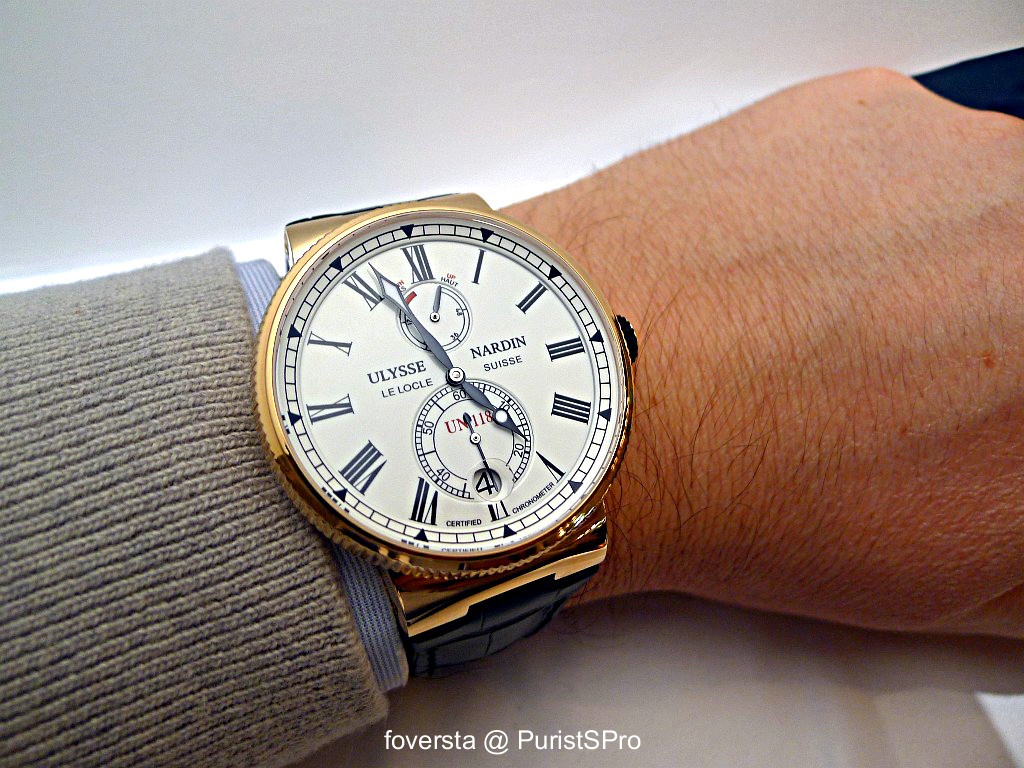
The enamel dial/pink gold version is limited to 350 pieces.
The unlimited variant in steel finally shows a decent renovation of the well-known design: large, applied Roman numerals in polished steel, and skeletonized hands that have become typical for Ulysse Nardin. The departure from the classic design is not so radical that it would need a long time to become familiar with it.
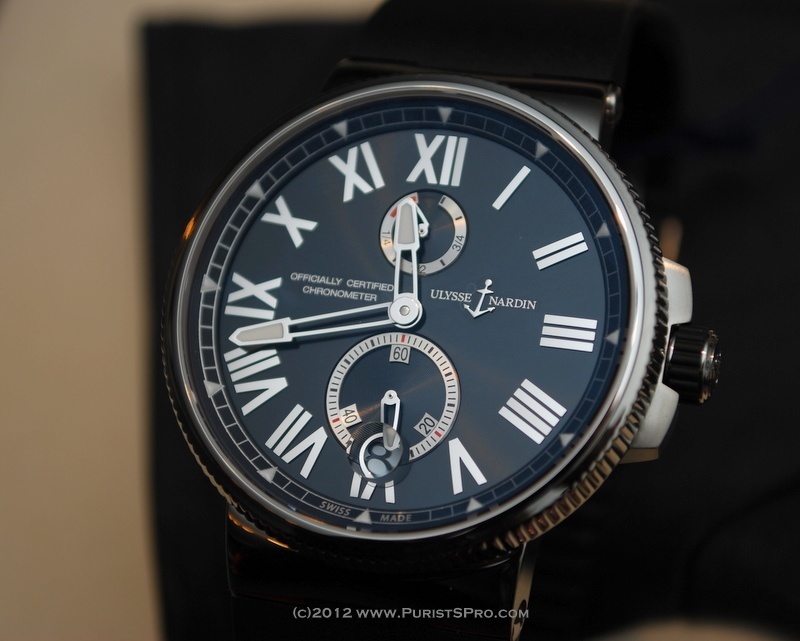
And, finally, there is a watch we had already lively discussions about: the new Sonata Streamline. When I was able to conduct a longtime test of an early prototype of the Sonata Silicium, it was clear already that the technology to replace the traditional Swiss lever escapement of the Sonata with a silicium escapement, without having to completely change the rest of the movement, would become a standard of the Sonata one day. After the first, still limited edition of the Sonata Silicium, now the massively facelifted Sonata Streamline benefits from the new escapement technology.
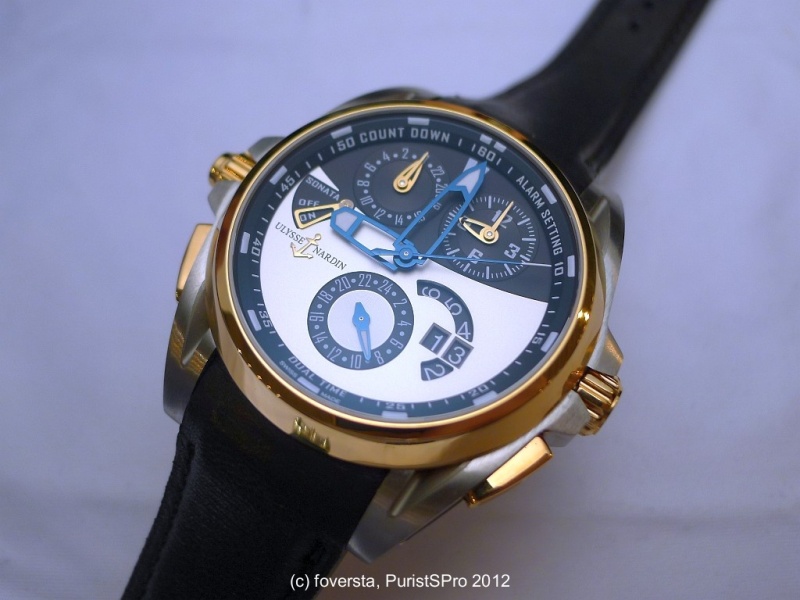
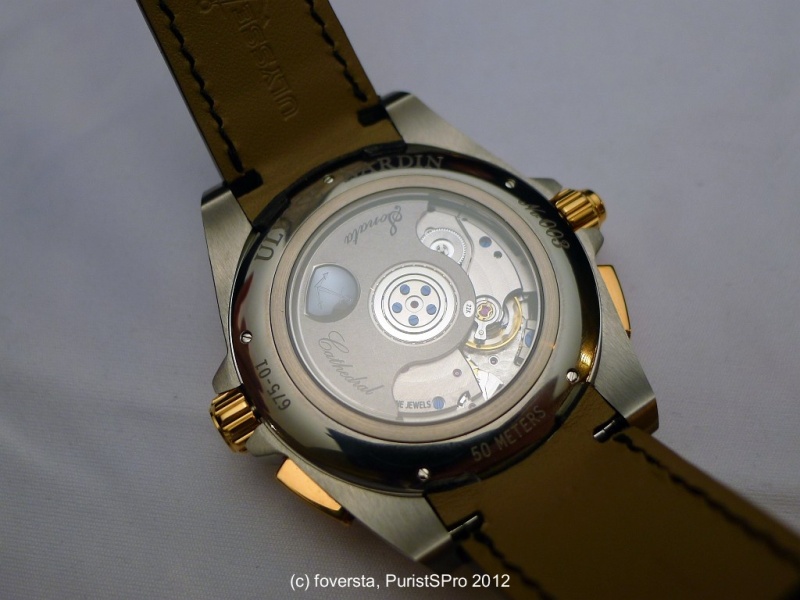
http://basel.watchprosite.com/?show=nbl ... 353&fi=636
2012 - for Ulysse Nardin this is the first Basel fair without its energetic and charismatic leader Rolf Schnyder, who had passed away so suddenly in April 2011. As a consequence, many were uncertain about the company’s new course, some even predicted a decrease of impetus and innovation.
Gladly, this year’s fair demonstrate the opposite: Aside personal loss and grief, nothing seems to have changed, regarding Ulysse Nardin’s energy devoted to innovative technologies, the presentation of new models, and the consolidation of existing lines. Mainly responsible for that is the continuity within the company’s leadership: Already several years ago, Patrik Hoffmann, long-time head of Ulysse Nardin’s North American business, was appointed CEO and designated the successor of Rolf Schnyder in leading the company. Consequently, the business was not fatally interrupted by Rolf’s death.
For me, 2012 was the first year since thirteen years that I could not attend the Basel fair myself; a pneumonia had forced me to stay at home in the last moment. Therefore, my comments on the new models are based on my friends’ and colleagues’ observations solely. I also express my sincere thanks to Don and Francois-Xavier for supplying me the pictures they shot of the various novelties.
After Ulysse Nardin has amply demonstrated its competence to build state-of-the-art movements with complications, employing latest material and part design technologies, speculations about an own base movement were active during the last years. It is no secret that Ulysse Nardin heavily relied on base movements supplied by ETA in its most numerously produced watch lines, such as the Marine series, or the various GMT models. Since the Swatch Group announced the slow reduction of movement sales to companies not part of the group, it was clear that an alternative had to be found.
In 2011, Ulysse Nardin presented the cal. 118, a solid base movement, equipped with high-end escapement technology: while the escapement design relied on the traditional Swiss lever, the materials used are exclusive to Ulysse Nardin - anchor, escapement wheel and hairspring being made from DiamonSil, a silicium core vapour coated with synthetic diamond.

All these components are produced by Sigatec, a leading company specialised on the development and production of nano-parts from silicium, synthetic diamond - or the combination of these two materials. Ulysse Nardin owns a major share of this company, that also delivers components to many other watch manufacturers.

Closer examination of this movement made clear that it would become the new base movement of the Marine series: a power reserve display at 12, and a small second at 6, combined with a conventional date at 6 (no big date), that can be quick-set forward and backward. While up to now, a self-produced module was necessary to add the typical configuration to an ETA 2892A2, the new cal. 118 has everything on board needed by the Marine series watches.
Thus it was only a question how the new Marine chronometers would look, when finally, they were released at this year’s Basel fair. The first sight fell on the limited series Marine Chronometer in 18k pink gold case, with a white enamel dial and finely printed Roman numerals: not that much of a difference with what we are used to, I thought. The increased diameter of 45mm, however, already indicates the changes.


Not all are happy about the large case. When the first Marine Chronometer was launched in 1996, it had a diameter of a bit more than 38mm. Times and fashion have changed since, the latest variant, the Maxi Marine, already has a diameter of 43mm, still retaining the original base movement with only 25.6mm diameter. The new cal. 118 is considerably larger (about 5mm), since it was designed from the outset to be robust and reliable. It is thus not astonishing to see the case grown as well. Yet the friends of decently sized watches should not abandon all hope: With 31.6mm diameter, the cal. 118 should permit cases in the 42mm class, so maybe we will see more compact Marine Chronometers in the future.

The enamel dial/pink gold version is limited to 350 pieces.
The unlimited variant in steel finally shows a decent renovation of the well-known design: large, applied Roman numerals in polished steel, and skeletonized hands that have become typical for Ulysse Nardin. The departure from the classic design is not so radical that it would need a long time to become familiar with it.

And, finally, there is a watch we had already lively discussions about: the new Sonata Streamline. When I was able to conduct a longtime test of an early prototype of the Sonata Silicium, it was clear already that the technology to replace the traditional Swiss lever escapement of the Sonata with a silicium escapement, without having to completely change the rest of the movement, would become a standard of the Sonata one day. After the first, still limited edition of the Sonata Silicium, now the massively facelifted Sonata Streamline benefits from the new escapement technology.


http://basel.watchprosite.com/?show=nbl ... 353&fi=636
